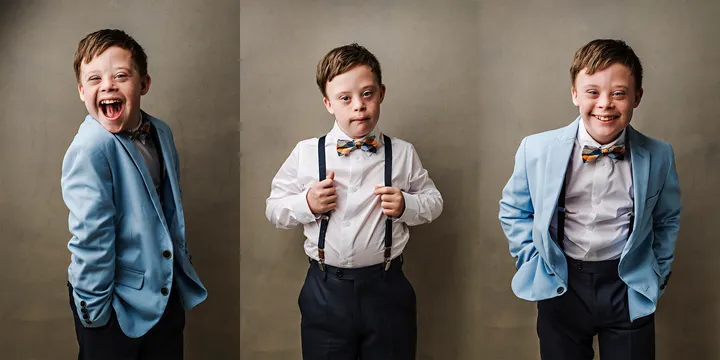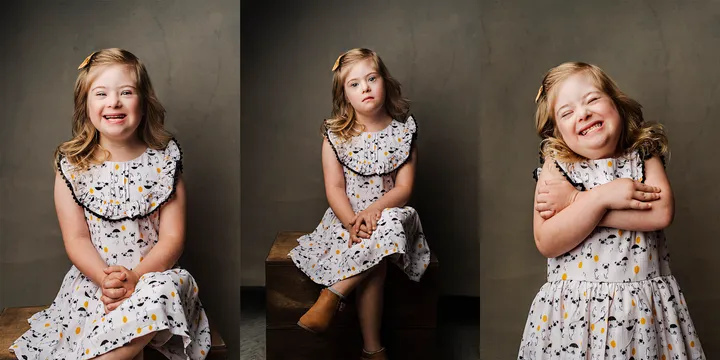Down Syndrome Photo Series ‘More To Me’ Shatters Myths
Connor Garel | Huffington Post, November 4, 2019
A Canadian project shines light on the range of emotions those with the syndrome experience.
“Typically, when people see somebody who has Down syndrome, it’s the first thing that they see,” Vanessa Richard, a mother and the social media coordinator for the Waterloo Regional Down Syndrome Society (WRDSS) in Waterloo, Ont., told HuffPost Canada. “Often times, it’s the only thing that they see. They don’t even see the person.”
Two years ago, Richard’s son Jamie was born with Down syndrome. Since then, she’s seen firsthand how easily people can fall into the traps set by misconceptions about the developmental disorder.

This timeworn social problem — the refusal or inability to see beyond a person’s disability — is the subject of a new series by Waterloo-based photographer Hilary Gauld-Camilleri, owner of One for the Wall Photography. Her new campaign, “More to Me,” aims to shift the way people look at those who have Down syndrome.
Down syndrome is a developmental disorder commonly associated with physical growth delays, mild to moderate cognitive disability, and characteristic facial features, such as a flattened face. It affects one in every 781 births in Canada, the Canadian Down Syndrome Society reports. Canadian Down Syndrome Week, which seeks to teach others to “see the ability,” is marked Nov. 1-7.
“The idea is to challenge you to look twice, and to look past how someone might look on the outside,” Gauld-Camilleri told HuffPost Canada over the phone. “There’s so much more to them, in the same way that there’s so much more to any of us, than what you immediately see on the outside.”

Gauld-Camilleri’s images might look stylistically familiar. Each photo in the series, which is timed to Canadian Down Syndrome Week, is meant to evoke the way a photographer might shoot a celebrity for the cover of a lofty, glossy magazine.
The lighting is moody, the expressions are varied, the poses are dynamic: it’s rare among the imagery we typically see of people who have disabilities.
“Children and adults with Down syndrome are typically photographed in these bright, happy environments,” Gauld-Camilleri said. “But this was about putting a light on them — literally and figuratively, putting a light on them — that we aren’t used to seeing them in.”


With each photo that she took, Gauld-Camilleri asked the families to provide a stereotype that they felt still existed about people with Down syndrome. Many of the families reported the same myth: that people with Down syndrome are always happy.
To be clear: they aren’t. “It’s important for us to understand that people with Down syndrome have a range of emotions,” Gauld-Camilleri said. Through the images, she wanted to illustrate that they also have the ability “to get angry and sad, to feel joy and to feel fear, in the same way that everybody else can and does.”
Although the photographer doesn’t have a family member with Down syndrome, she’s helped bust myths and stereotypes for mothers like Richard.


When Jamie got his diagnosis, Richard immediately began searching for resources. She wanted to know more about what the diagnosis meant, and was eventually referred to Gauld-Camilleri, who had, a few years before, produced a full calendar that captured humanizing portraits of members of the WRDSS.
When Richard first saw the images from the calendar, something shifted for the mother. “It was through that calendar that I was able to really see what the real look of Down syndrome was: that it’s completely normal,” Richard said.
“As a new parent, it was wonderful just to see that. There were photos of kids just playing in backyards with their families, playing on swings, hanging out in the front yard playing street hockey. It was a closer look, and it wasn’t scary.”

Since then, Gauld-Camilleri’s project has become a powerful advocacy campaign, and each year, she fields concerns from families in order to advance the movement to show folks with Down syndrome in all of their complexities.
“People with Down syndrome can still be fantastic contributors to our communities. They can go to school, they can hold long-term jobs, they can get married, they can go to college,” Richard said. “The disorder isn’t all that they are. It’s not all-consuming. We want to shatter that misconception.”
About This Article:
A Life Worth Living has copied the content of this article under fair use in order to preserve as a post in our resource library for preservation in accessible format. Explicit permission pending.
Link to Original Article: https://www.huffingtonpost.ca/entry/down-syndrome-myths-photos_ca_5dbc9fe0e4b0576b62a1efbf

